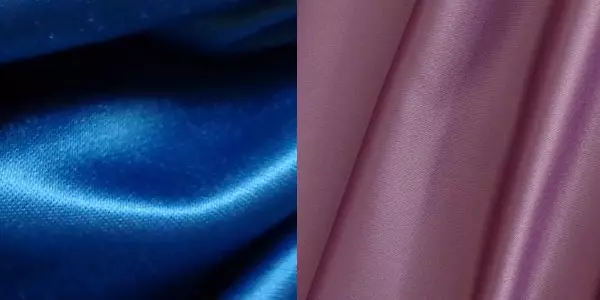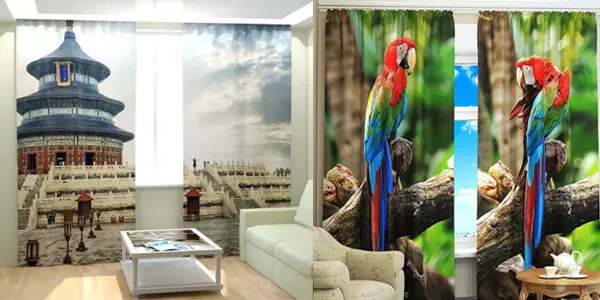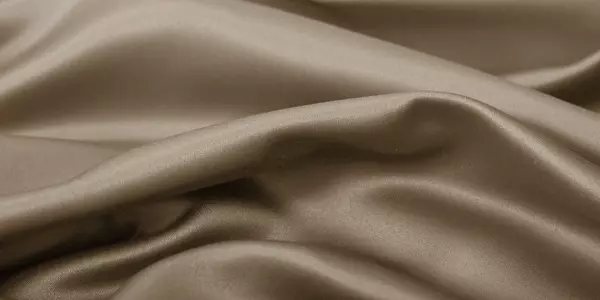In many languages, the French name "Satin" still recently denoted atlas - both cotton and silk. Over time, the word "satin" began to denote the tight cotton material of a special interlacing with a characteristic glossy surface, and the names of Saten or satin (lightweight variety of satin in striped), it seemed forever moved to the fashion history. However, most recently, these terms appeared again in the catalogs of manufacturers and textile sellers. Currently, Satuten's word (less often satin) - they call the synthetic tissue of a special interlacing, from which curtains and various accessories are manufactured.

Modern Satuten - what is it?
Textiles with such titles is made of polyester fibers or their mixture of polyester and cotton. Its feature is satin (Satenova) interlacing, in which the wrong side remains matte, often with a noticeable graininess, and the facial - silky, resembling the atlas. However, unlike satin Satuten has a restrained noble defill and does not create glare . This material has the most diverse use. It is sewed from it, first of all, curtains and various curtains, as well as bags and other accessories, use for various bedding, various homemade and decorative textiles, are used as lining.This tissue play a special role when designing various interiors, especially business. From it often produce flags, panels, a variety of objects with individual and corporate logos. This contributes to these properties of this textile as:
- strength;
- wear resistance;
- Elasticity and at the same time the ability to maintain a given form;
- Ability to be beautifully draped;
- Good light scattering and soundproofing properties.
This fabric can have a variety of colors, be smooth or jacquard. It looks very rich, while its price is not too high. But since polyesters have bad heat insulating and hygienic properties, it is not recommended to use Saten for clothing and bed linen (theatrical costumes are exceptions) . However, it is widely used as a porter tissue, as well as material for creating corporate and festive design of premises, art objects, etc.
Like any polyester fabric, satin is very easy to care. It is well tolerating the machine washing in warm water and does not need to iron, although you allow the iron from the reverse side.
What are good curtains from satin
Such a curtain fabric, like Satuten, along with the gabardine and blackout, is the top three materials that are best protected from light radiation. This largely contributes to the fact that Satuten can have different density - from 130 to 280 g / sq. meter, as well as a varied width, up to 360 cm inclusive. The stitched curtains are beautiful, very durable, well dispel the light, absorb sounds, so they are often used for recording studios. For public premises, the curtain fabric Satuten is supplied with a special refractory impregnation, which makes it use absolutely safe even in children's institutions.
Article on the topic: Knitting patterns of patterns and motifs Crochet - My selection

Satuten's special popularity has acquired due to the fact that it is one of the best bases for photo printing . Drawings on a white smooth canvase are very bright and clear, they do not fade and wear washing well. Such curtains with a photographically accurate image allow you to create an unusual interior of the most diverse style.
Saten varieties
This beautiful and fashionable curtainic fabric is produced in many countries, and each manufacturer gives its own classification of its products. Among the types of satin presented in our market are the most famous:
- Normal - with a density of 180 g / sq. meter, which can have a variety of monophonic color;
- The display is a particularly smooth surface, ideally suitable for applying photo images, usually has a white color. It makes curtains with photographic curtains, also it is used for decorative panels, tablecloths, pillows;
- Light is a thin material with a density of 140 g / sq. meter, most often used for the manufacture of flags, panel, interior drapes;
- Premium - top quality fabulous with a density of 180 g / sq.meter, with impregnation for thermal transfer printing and light grainy structure, which allows you to create drawings of very high accuracy and with spectacular transitions of colors and shades .Ideal for souvenir products, fashion accessories, artistic panels , state and corporate symbolism.
- Atlas Premium is a smooth fabulosis of the highest quality of high density (190 g / sq. Meter).

All materials listed above can be equipped with fire-resistant impregnation (their technical description necessarily contains this item), which makes them non-carriage and admissible to use in public and commercial buildings. Several varieties of Saten are produced, for which fire-resistant impregnation is mandatory. The most famous variety of such non-combustible, and at the same time decorative canvas, is the Crysphri exclusive . This canvas has a very high density (280 g / sq. Meter) and a special multifunctional impregnation, which provides:
- moisture resistance;
- wind protection;
- effective light scattering;
- light scattering;
- resistance to fire;
- The ability to apply the image direct, thermal transfer, latex and uv - methods.
Article on the topic: Weaving from rubber without a machine for beginners with photos and video
This material has a width of 266 cm and, in addition to the usual applications, can be used for canopies, tents, umbrellas, advertising structures, inflatable structures.
Saten varieties created on the basis of a mixture of polyester and natural (usually cotton) fibers are not cheap and appear on sale relatively rarely. Bed and table linen, clothing, curtains and various accessories are manufactured.
